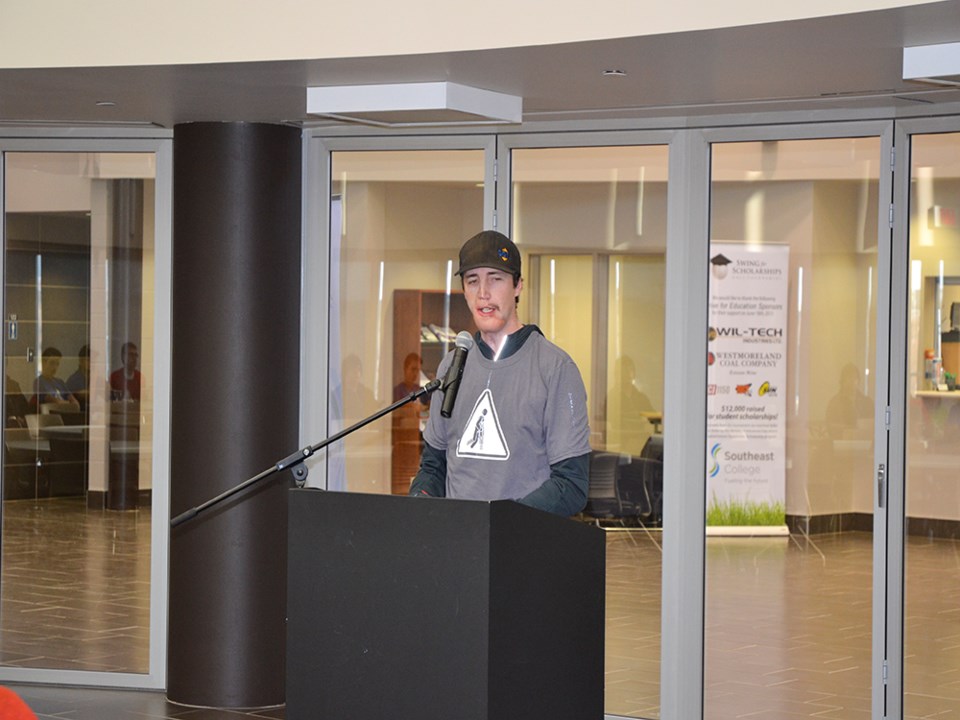Students at the Saskatchewan Energy Training Institute and Southeast College got a firsthand account of the dangers that can arise if the proper precautions are not taken to avoid workplace injuries. Members of the WorkSafe Saskatchewan Street Team paid a visit to the institute, accompanied by Curtis Weber, a workplace injury survivor and advocate of proper workplace safety and workers’ rights.
“My injury happened, interestingly enough, on the third day of my job. I was too shy to ask questions about what we were doing that day,” said Weber, who was 17 at the time of the injury. “We were attempting to move a steel structure underneath an overhead line.”
Weber noted that in spite of there being plenty of awareness of the hazards associated with such an operation, the structure caught on a line while he and a crew of six other workers tried to maneuver it. While he was holding onto the structure, Weber was electrocuted three times, by over 40,000 volts of electricity. During his first four nights in the hospital, doctors thought he wouldn’t survive his injuries.
Weber’s injuries prevented him from playing Junior A hockey, kept him in the hospital, for almost seven months, requiring him to undergo over 30 surgeries in Saskatoon and Toronto, including reconstructive and plastic surgery.
“I spent the next six years of my life though through physiotherapy and getting surgery. That amount of time was completely consumed due to that one bad decision I made not to voice my concern for a bad decision on my employer’s part,” said Weber. “It’s important for us to be able to hold onto our own choices and decisions.
“There should be a joint-accountability approach and we should be looking out for our own safety instead of relying on other people to keep us safe.”
Weber spoke of how important it was that the youth of Saskatchewan and the employers that hire them must be focused, when it comes to creating widespread attitudes that promote workplace safety. He noted that attitudes and behaviour are the most important aspects to change among young people.
At the presentation, students were given T-shirts in a variety of different colours, each representing a statistic relating to workplace injuries. Half of the students were given red shirts, representing the half of injuries sustained on the workplace being burns, cuts and crush injuries to hands; and about a tenth of the students were given blue shirts, which represented eye and vision injuries at the workplace.
Students were surveyed with situational “what-would-you-do” questions on workplace safety protocol, which served as a springboard to a broader discussion on the topic, at the brief, but focused lunch event.
Kelsey Boyd, a member of the WorkSafe Saskatchewan Street team serving as a hostess for the workshop, emphasized the importance of speaking up, especially among younger workers — a demographic that is particularly prone to workplace injuries. She noted the T-shirts are a strong visual, to give perspective on just how many people are affected by workplace injuries.
“It’s often a whole ‘I’m invincible’-type of thing, compared to older, more experienced workers,” said Boyd. “(Younger workers) don’t always know the tricks of the trade, so they don’t want to ask. They want to go along and not slow down the process or get in the way.”
Weber agreed, noting there is a great deal of pressure for younger workers to integrate with older more experienced workers. In their eagerness to fit in, they often overlook their own rights and safety requirements. He noted that educating younger workers and giving them the confidence to ask questions and voice safety concerns is incredibly important.
“A lot of people aren’t aware of their basic rights as workers,” said Boyd. “They don’t know they have the right to refuse unsafe work. That’s a big one.”
Weber added that in addition to rights, many young workers aren’t aware of the dangerous statistics associated with them.
“These guys are with us, going through the stats and realizing that these things really do happen,” said Weber. “They’ve lived their lives to this point without injuries, and all of the sudden, they now have responsibility, they’re going to work and they’re accountable to themselves and coworkers,”
The presentation ties in with another one of WorkSafe Saksatchewan’s campaigns: Mission Zero. Mission Zero is an initiative that began in 2008, with the objective of eliminating all workplace injuries in Saskatchewan. The initiative is focused on educating workers to make healthy safe changes to their behaviour and attitudes, by reducing
unnecessary risks.




